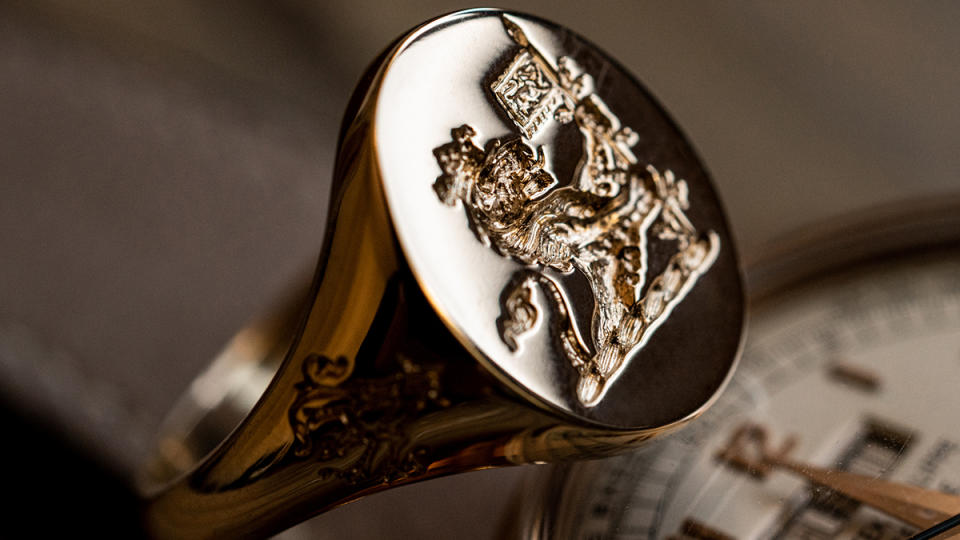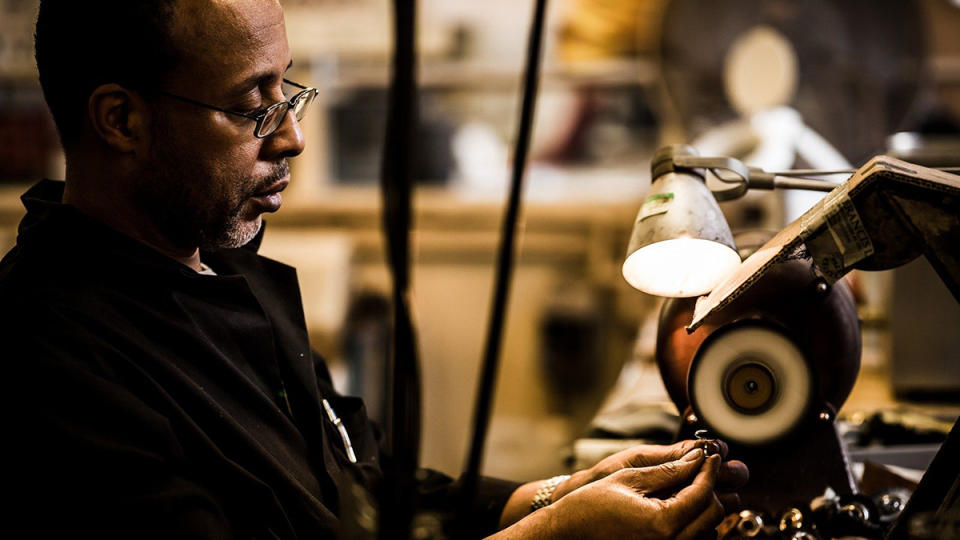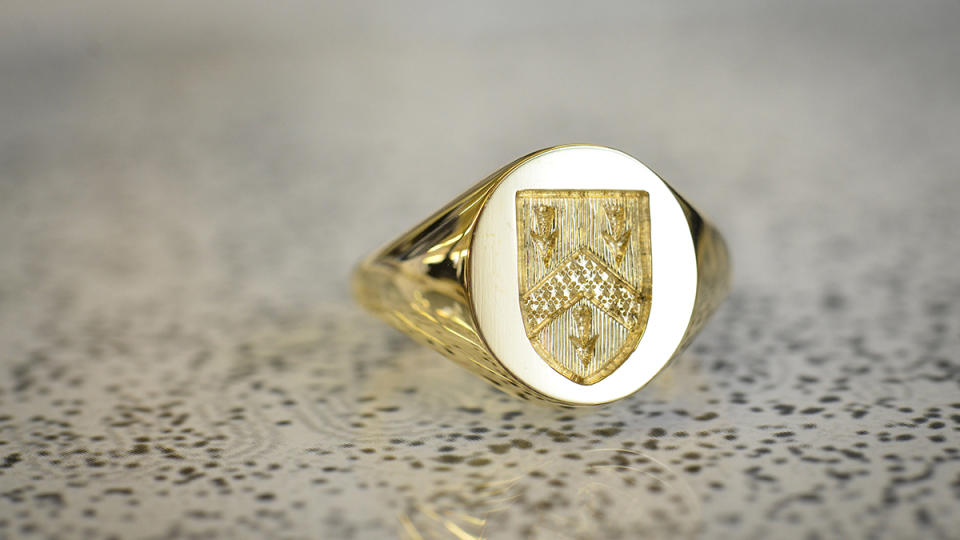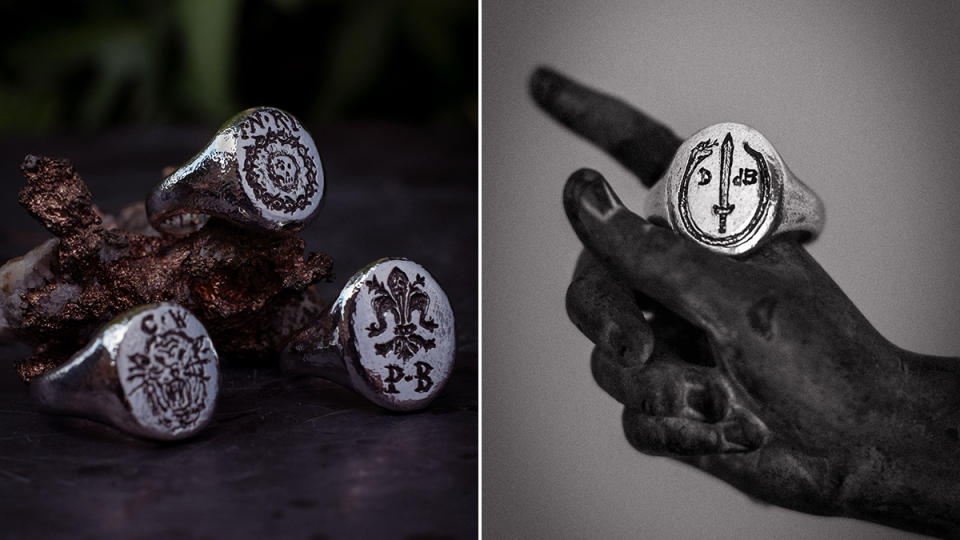Signet Rings Are Back. Here’s How to Wear Them.

Guys are increasingly comfortable with wearing jewelry once considered off-limits—look no further than men wearing pearl necklaces or gem-set brooches as high-wattage lapel pins. So, it’s ironic that the signet ring—perhaps the most classic of men’s accessories—can still feel inaccessible to those without a family crest.
Now, if you happen to be wearing an heirloom that’s been passed down in your family for generations, you can stop reading here (goodbye, Charles). But the rest of us may have questions, such as: What to engrave if I don’t have a coat of arms? Must it always be worn on the pinky finger? And just where did the signet ring come from, anyway?

“Signet rings, used since ancient Egyptian times for their unique seals, served as marks of authority and authenticity,” says Henry Deakin, managing director of the Piccadilly Arcade jeweler Deakin & Francis, which was founded in 1786 and rates as the oldest manufacturing jeweler in England. “Over centuries, they evolved from essential legal tools to status symbols and fashion accessories often reflecting personal and familial identity.”
As they went from serving a utilitarian purpose to satisfying an aesthetic one, it was only natural that they be engraved with the ultimate power move: a family crest or coat of arms.
“Historically a surname would be referenced, in a large dusty book that we have had for over 100 years, to find the crest or coat of arms it relates to,” Deakin continues. “However, we have seen a huge increase in customers making use of our bespoke design service to create something more personal and intimate from scratch over the last few years.”
More from Robb Report

It’s a change that Rachel Constantine, international design consultant for the City of London-based ring maker Rebus, has also noticed, particularly during trunk shows in the U.S. She cites the example of a soon-to-be-married American couple whose rings were engraved with the image of a rhino eating a radish while a skeleton leaned jauntily against the animal’s hide. While that might sound like a puzzling tableau to the public at large, the design symbolizes aspects of the couple’s early relationship.
“We want to preserve the tradition of the craft and the tradition of heraldry, but then we also love to embrace this more contemporary angle for the customer who wants something a bit different,” says Constantine, who estimates that about 60 percent of Rebus clients have an existing family crest.
Signet rings were traditionally worn on the pinky of the non-dominant hand, for a practical reason: they would be used to stamp the wax seal of a letter after the favored hand had written it. Today, Constantine says that the ring finger is a “close second,” adding, “I think I’ve done one for someone on pretty much every finger you can have. So that sort of tradition has evolved quite a lot.”

Another way that the signet ring has transitioned is the matter of who is wearing one—and why. Traditionally a men’s adornment, it’s become increasingly popular with women: they constitute about 40 percent of the Rebus clientele. And while traditionally presented as an 18th or 21st birthday present, signet rings are increasingly gifted to commemorate a major life event such as a graduation, the birth of a child, or as a wedding band alternative.
In the popular imagination, the signet ring is most closely associated with the British aristocracy—and their WASP offshoot in America—and pictured as a smooth piece of highly polished gold. That assumption is being challenged by L’Arte Nascosta, an online business that works with a variety of Italian artisans, including the Florentine master goldsmith Paolo Penko.
Through its website, L’Arte Nascosta invites clients to commission the “Ellenistico” signet ring, a design developed in collaboration with Penko that calls back to the style of signet ring that would have been worn in ancient Rome. Made from either sterling silver or 18k rose gold, the rings are marked by a purposefully rough, hammered “cesoro” finish that draws on ancient Etruscan jewelling techniques and makes the final product a little easier to dress down.

“The rings, since they’re not quite so ‘perfect’, feel more approachable,” says L’Arte Nascosta founder and creative director Salvatore Ambrosino. “They’re more suitable to various circumstances, whether it’s with a suit or just wearing a T-shirt and jeans.”
Piggybacking on the style’s more casual feel, Ambrosino encourages patrons to treat them like “amulets,” meaning a blank canvas with which to engrave a symbol imbued with personal meaning rather than a coat of arms, an exercise he likens to getting inked.
“I thought that a ring might be the perfect canvas to convey some of those ideas on an object that you can quite literally take off and pass down to the next generation to create some sort of legacy,” he continues.
Of course, an heirloom has to start somewhere, which is how we’ll direct our last question on the topic of signet rings: What are you waiting for?
Best of Robb Report
Sign up for Robb Report's Newsletter. For the latest news, follow us on Facebook, Twitter, and Instagram.
